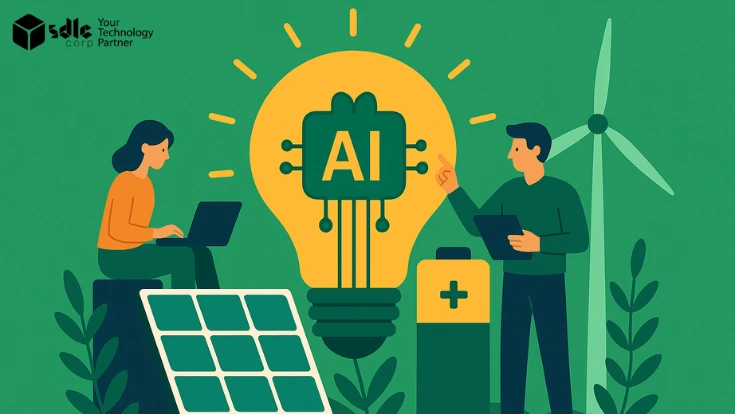Introduction
AI in energy has become vital for modern power systems that must deliver reliability, sustainability, and efficiency. Advanced algorithms now process massive datasets in real time, enabling smarter energy generation and distribution. As a result, utilities and providers achieve stronger performance and greater resilience.
In renewable energy, machine learning predicts wind variations, forecasts solar radiation, and improves battery storage management. Smart grid AI balances supply and demand, prevents outages, and connects clean energy with existing systems. Predictive analytics ensures renewable resources stay competitive without sacrificing stability.
At the same time, AI in oil and gas boosts drilling precision, strengthens pipeline safety, and increases equipment reliability. Robotics and computer vision take over hazardous inspections, reducing human risk. Predictive maintenance identifies issues before they escalate, cutting downtime and limiting environmental impact. This article highlights how AI fuels innovation across renewable energy, smart grids, and oil and gas. It shows why artificial intelligence has become the foundation for efficient, resilient, and sustainable energy operations. To explore more, visit AI Development Services
1. The Landscape of AI in Energy
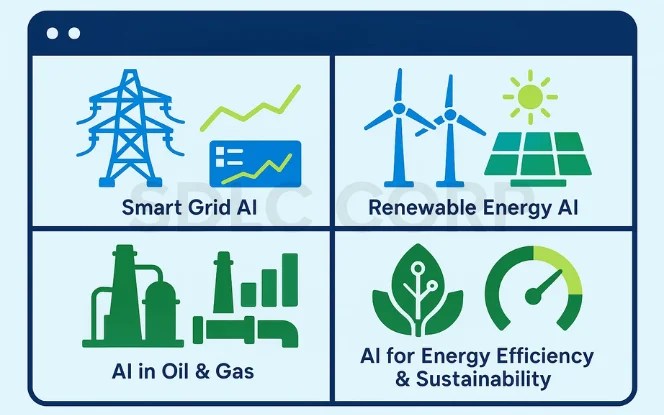
AI in energy spans a wide range of technologies that collectively improve efficiency, reliability, and sustainability. These tools are not confined to a single sector. Instead, they form a connected ecosystem where smart grid AI, renewable energy AI, and AI in oil and gas work together to strengthen operational performance.
Core AI Technologies in Energy
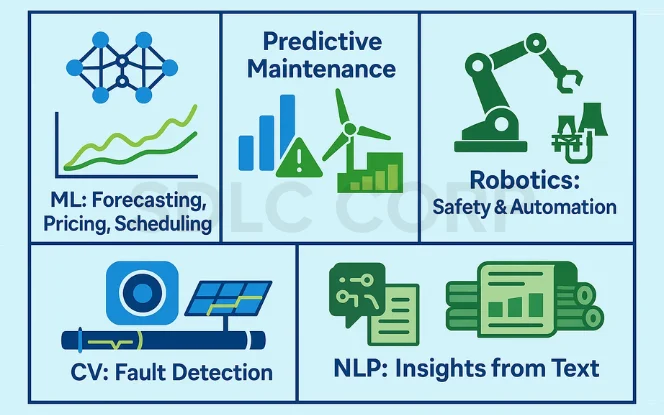
- Machine Learning (ML): Enhances demand forecasting, dynamic pricing, and renewable scheduling. Supervised models predict load patterns, while deep learning interprets sensor-heavy environments such as smart grids.
- Predictive Analytics: Powers predictive maintenance by spotting failure trends in turbines, substations, and drilling rigs. As a result, downtime decreases and repair costs are minimized.
- Robotics: Plays a vital role in high-risk inspections at nuclear plants and offshore rigs. Robots not only improve worker safety but also automate repetitive tasks.
- Computer Vision (CV): Identifies cracks in solar panels, corrosion in pipelines, and irregularities in industrial equipment.
- Natural Language Processing (NLP): Analyzes operator logs, trading reports, and customer feedback to deliver actionable insights.
Table: AI Technologies and Energy Applications
| AI Technology | Applications in Energy |
|---|---|
| ML | Renewable forecasting, smart grid management, dynamic pricing |
| Predictive Analytics | Predictive maintenance, asset optimization, trading risk evaluation |
| Robotics | Offshore drilling, nuclear inspections, automated equipment repair |
| CV | Pipeline monitoring, solar panel crack detection, substation anomaly analysis |
| NLP | Customer service bots, energy trading insights, report interpretation |
Cross-Sector Relevance
AI in energy unites renewable technologies with oil and gas applications. For instance, ML models predict wind speeds for turbines, while robotics perform safer inspections on offshore platforms. These innovations lower risks, improve asset performance, and promote sustainable growth across both traditional and renewable sectors.
Learn More: Generative AI for Energy
2. AI in Traditional Energy Sectors
AI in Oil & Gas
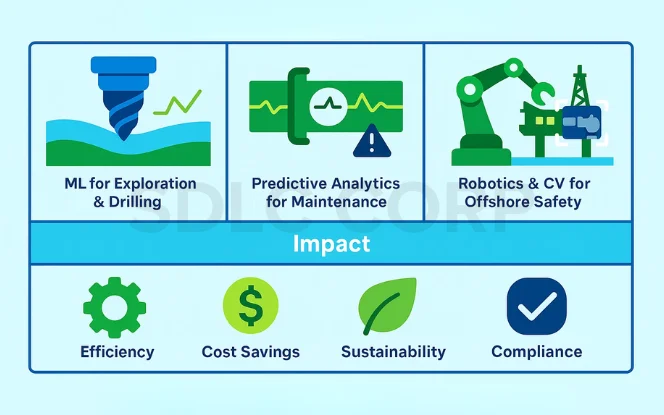
AI is transforming oil and gas by modernizing exploration, drilling, and equipment maintenance.
Exploration & Drilling Optimization
- ML evaluates seismic records, geological layers, and drilling history.
- Algorithms refine well placement and adjust drilling parameters in real time.
- As a result, exploration becomes quicker and more accurate.
Predictive Maintenance in Pipelines & Rigs
- Sensors monitor pressure, vibration, and temperature data.
- Predictive analytics forecasts leaks or signs of mechanical wear.
- As a result, expensive shutdowns are avoided.
Robotics & CV for Offshore Safety
- AI-powered robots conduct inspections on offshore rigs.
- CV identifies leaks, corrosion, and equipment defects.
- These systems significantly reduce human exposure to hazardous conditions.
Impact: AI in oil and gas improves efficiency, cuts costs, and supports sustainability while reinforcing compliance with safety and environmental rules.
AI in Nuclear Power
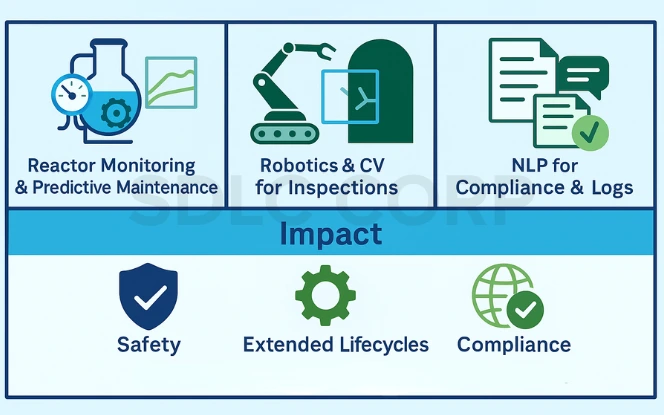
In nuclear power, AI strengthens safety, precision, and predictive operations.
Reactor Monitoring & Predictive Maintenance
- Algorithms track coolant flow, pressure, and reactor temperatures.
- Predictive models anticipate potential component failures.
- As a result, operators avoid unplanned outages.
Robotics in Hazardous Inspections
- Robots with CV investigate reactor interiors.
- Automated systems detect cracks and corrosion beyond human visibility.
- Worker exposure to radiation-heavy zones is greatly reduced.
NLP for Compliance & Logs
- NLP analyzes operator notes, incident reports, and maintenance records.
- Insights reveal recurring issues and compliance gaps.
- As a result, adherence to safety standards improves.
Impact: AI enables nuclear facilities to enhance safety, extend asset lifecycles, and maintain compliance with global regulations.
3. AI in Power Generation & Smart Grids
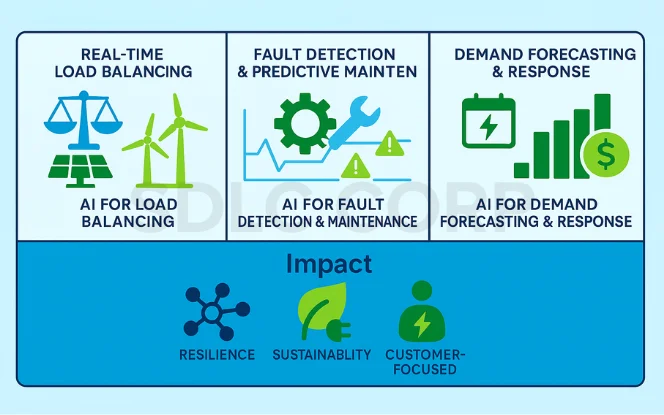
Smart grid AI is reshaping how electricity is produced, delivered, and consumed. It enables grids to balance supply and demand in real time, detect faults instantly, and integrate renewable sources more efficiently.
Real-Time Load Balancing
- AI tracks energy consumption across different regions.
- Renewable energy AI reduces the variability of solar and wind supply.
- As a result, power overloads and blackouts are avoided.
Fault Detection & Predictive Asset Maintenance
- Sensors combined with ML models identify irregularities in transformers and cables.
- Predictive analytics anticipates failures before they happen.
- Utilities lower repair costs and boost overall uptime.
Demand Forecasting & Response
- AI systems project demand patterns by hour, day, and season.
- Smart grid AI supports flexible demand-response programs.
- Customers are rewarded for conserving energy during peak periods.
Impact: AI in power generation creates a self-adjusting grid where renewable technologies, predictive analytics, and automation work together. As a result, grids grow more resilient, sustainable, and customer-focused.
4. AI for Renewable Energy Optimization
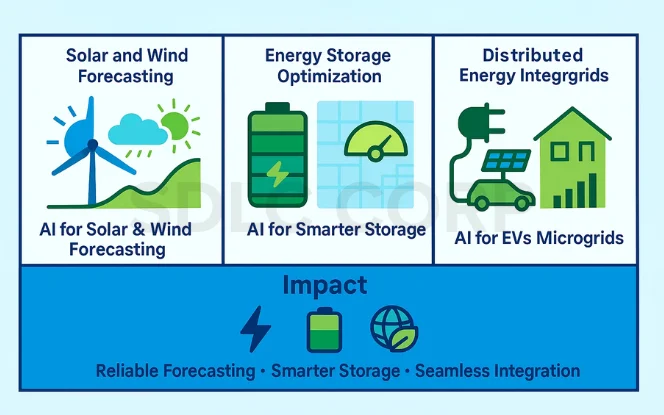
Renewable energy AI tackles one of the sector’s biggest challenges: the variability of solar and wind generation. It delivers reliable forecasting, smarter energy storage, and seamless integration of distributed resources. As a result, utilities can expand renewable adoption without reducing stability.
Solar and Wind Forecasting with AI
- Machine learning systems analyze historical weather data, satellite images, and sensor readings.
- Solar forecasting estimates irradiance to enhance scheduling accuracy.
- Wind forecasting predicts turbulence and velocity, lowering uncertainty.
- As a result, power dispatch becomes more consistent and efficient.
Energy Storage Optimization
- AI-powered battery systems regulate charging and discharging cycles.
- Predictive analytics increases utilization during demand peaks.
- Smart grid AI synchronizes storage with distributed renewable inputs.
- Storage capacity is optimized, battery life extended, and costs reduced.
Distributed Energy Integration (EVs & Microgrids)
- AI platforms manage EV charging to prevent grid congestion.
- Microgrids with AI coordinate localized supply and demand.
- Demand-response programs schedule charging around renewable availability.
Case Study: Google DeepMind & Wind Farms
Google DeepMind applied AI to forecast wind output 36 hours in advance. As a result, the market value of wind energy rose by 20% as production was better matched to demand. This case illustrates how predictive analytics enhances both profitability and sustainability in renewable operations.
Read Also : Generative AI for Agriculture
5. Smart Energy Management in Buildings & Industry
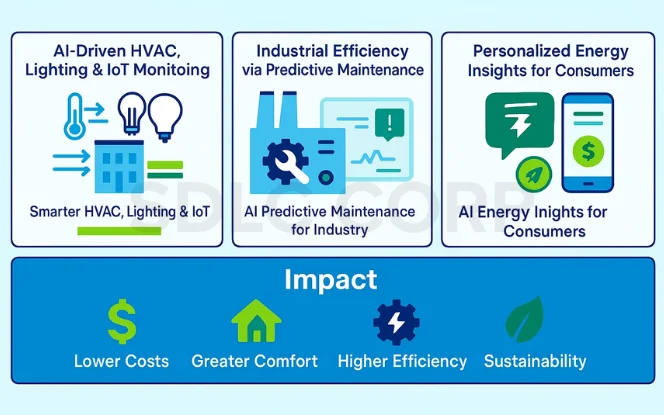
AI in energy goes beyond power generation by optimizing how buildings and industries consume electricity. With IoT, robotics, and predictive analytics, smarter energy management is now possible at every level.
AI-Driven HVAC, Lighting & IoT Monitoring
- HVAC systems: AI adjusts heating and cooling dynamically based on occupancy and weather.
- Smart lighting: Automated controls dim or switch lights off when not needed.
- IoT tracking: Connected devices provide real-time data on energy use.
- As a result, waste decreases while comfort and performance improve.
Industrial Efficiency via Predictive Maintenance
- Predictive models monitor vibration, temperature, and operational trends.
- Early alerts reduce the risk of expensive machinery breakdowns.
- Automated scheduling guarantees timely maintenance for key assets.
- Industrial uptime improves, and safety and compliance standards are strengthened.
Personalized Energy Insights for Consumers
- Renewable energy AI provides customized savings advice.
- Data-driven insights reveal off-peak usage opportunities.
- NLP assistants deliver real-time tips to reduce consumption.
- Consumers gain control over expenses while contributing to grid stability.
Impact: AI in buildings and industries lowers costs, boosts comfort, and enhances energy efficiency. As a result, both businesses and households move closer to long-term sustainability goals.
6. AI in Energy Trading & Markets
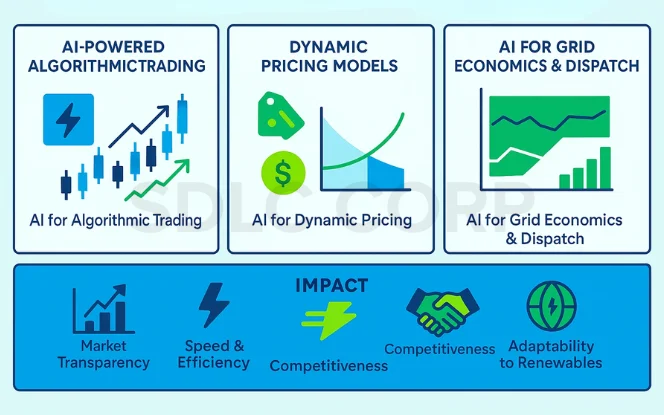
AI is transforming energy markets by delivering greater efficiency, speed, and accuracy in financial operations. Algorithmic trading and dynamic pricing models empower smarter decisions in a volatile sector.
AI-Powered Algorithmic Trading
- Real-time evaluation: ML analyzes demand, weather forecasts, and commodity trends.
- Automated execution: Transactions occur instantly, reducing the risk of human error.
- Profit optimization: Algorithms adjust to both renewable and fossil market conditions.
- Traders gain a significant competitive advantage.
Dynamic Pricing Models
- Tariffs shift in real time according to supply-demand balance.
- Fluctuations from renewables are factored into pricing.
- Incentives encourage customers to use energy off-peak.
- Dynamic pricing keeps market operations transparent and flexible.
AI for Grid Economics & Real-Time Dispatch
- Economic dispatch: AI allocates energy to cut costs.
- Demand forecasting: Smart grid AI predicts shifts in consumption.
- Market stability: Predictive analytics reduces disruptions in schedules.
- AI ensures stronger reliability and efficiency across energy economics.
Impact: AI in trading supports markets that are transparent, competitive, and adaptive to the shift from fossil fuels to renewables.
Check Out : AI for Agriculture
7. Case Studies: Real-World Applications of AI in Energy
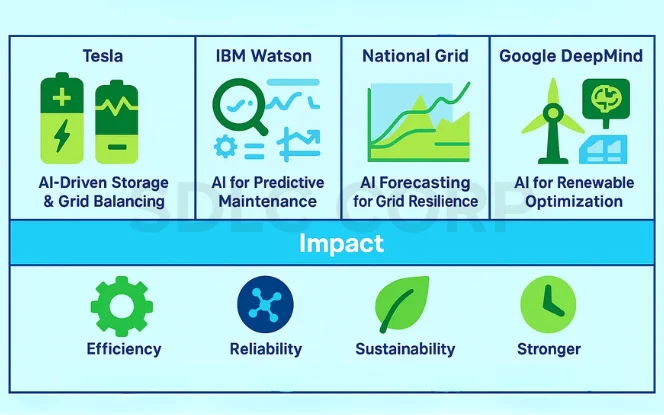
AI in energy is already being applied by global leaders to address challenges in forecasting, storage, and grid operations. These case studies show how renewable energy AI, smart grid AI, and predictive analytics deliver tangible improvements.
Tesla – Energy Storage & Grid Services
- Tesla employs AI-driven batteries to optimize charging and discharging.
- Algorithms anticipate demand and supply energy during peak times.
- As a result, renewable integration becomes more dependable.
IBM Watson – Predictive Analytics in Utilities
- IBM Watson applies ML to predictive maintenance in utilities.
- Sensor data is analyzed to detect problems before breakdowns occur.
- This raises uptime and reduces overall asset costs.
National Grid – Smart Grid AI Forecasting
- The UK’s National Grid uses AI to project demand levels.
- Forecasting tools enhance scheduling for both renewable and traditional sources.
- The grid becomes more resilient and efficient.
Google DeepMind – Renewable Energy Optimization
- DeepMind predicts wind output 36 hours ahead.
- The economic value of wind energy rises by 20% as scheduling improves.
- AI enhances both profitability and sustainability in renewable systems.
Impact: These examples confirm that AI in energy strengthens efficiency, reliability, and sustainability across diverse applications.
8. Benefits of AI in the Energy Industry
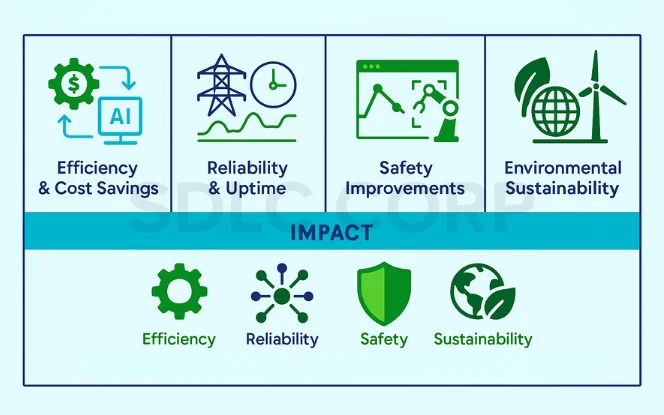
AI in energy delivers wide-ranging advantages that extend far beyond cost reduction. It ensures that grids, utilities, and industries function more safely, reliably, and sustainably.
Efficiency & Cost Savings
- AI-driven systems streamline generation, distribution, and usage.
- Predictive analytics lowers downtime and repair expenses.
- As a result, organizations secure long-term financial benefits.
Reliability & Uptime
- Smart grid AI manages supply in real time.
- Early fault detection avoids sudden outages.
- Customer trust and overall uptime both improve.
Safety Improvements
- Robotics and CV handle inspections in hazardous environments.
- Human exposure to risks is greatly reduced.
- Compliance with established safety standards also improves.
Environmental Sustainability
- Renewable energy AI increases integration of clean power.
- Fossil dependence declines, reducing emissions.
- AI actively supports international climate commitments.
Impact: By enhancing efficiency, reliability, safety, and sustainability, AI establishes the groundwork for the future of global energy systems.
Read More : Blockchain Developers and Their Contributions to Sustainable Energy
9. Challenges & Limitations of AI in Energy
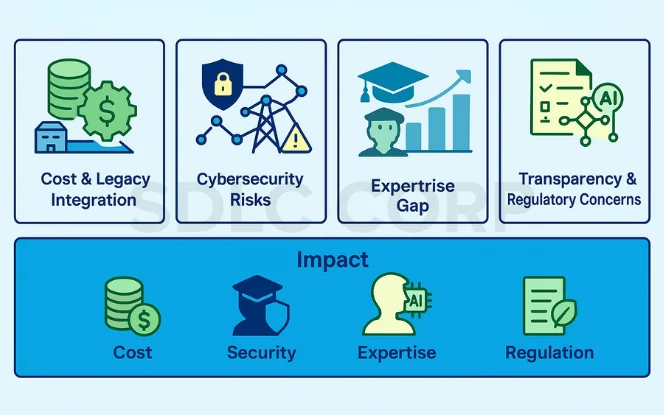
Although promising, AI in energy still encounters serious adoption barriers. These obstacles include financial, technical, and security concerns.
Cost & Legacy Integration
- Smart grid AI depends on advanced infrastructure.
- Outdated systems often lack compatibility with AI tools.
- As a result, high implementation costs remain a hurdle.
Cybersecurity Risks
- Greater grid connectivity through AI widens the attack surface.
- Utilities must implement stronger cybersecurity frameworks.
- Investment in digital resilience has become essential.
Expertise Gap
- There is a shortage of specialists in AI, ML, and robotics.
- Delays in training and recruitment slow down deployment.
- Workforce growth is essential for steady progress.
Transparency & Regulatory Concerns
- AI in both renewables and oil and gas must use explainable models.
- Regulators emphasize transparency in decision-making.
- Trust and compliance challenges continue to be critical.
Impact: Addressing these challenges is vital for AI in energy to achieve secure, scalable, and sustainable adoption.
Explore More : AI for Environmental Management
10. Future Outlook: AI and the Energy Transition
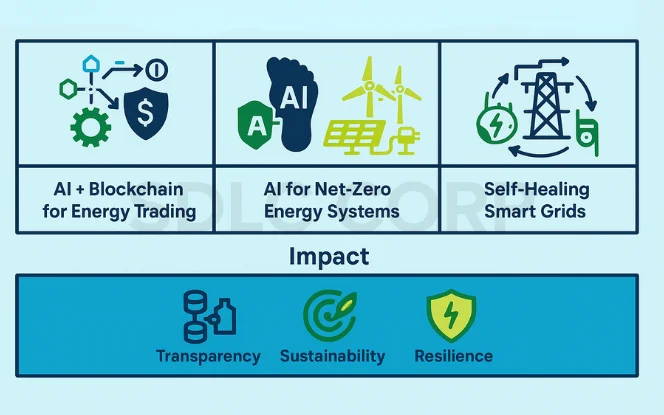
AI will remain at the heart of the global shift toward decarbonization. Alongside blockchain, advanced storage, and self-healing grids, it opens new opportunities for energy innovation.
AI + Blockchain for Energy Trading
- Peer-to-peer trading: AI with blockchain enables secure decentralized exchanges.
- Transparency: Blockchain’s immutability guarantees trusted market records.
- Efficiency: AI manages dynamic pricing and settlement automatically.
- As a result, energy markets become fair, transparent, and decentralized.
AI for Net-Zero Energy Systems
- Carbon tracking: Predictive analytics calculates emissions across operations.
- Optimization: Renewable energy AI streamlines integration of solar, wind, and EVs.
- Net-zero strategies: AI tools guide companies toward climate targets.
- Therefore, AI is indispensable in meeting global sustainability commitments.
Self-Healing Smart Grids
- Fault detection: Smart grid AI identifies disruptions immediately.
- Automatic reconfiguration: AI reroutes power to restore balance.
- Resilience: Systems adapt quickly to cyber threats or natural disasters.
- Self-healing grids increase reliability while limiting downtime.
Impact: The future of AI in energy blends resilience, sustainability, and transparency, creating a strong foundation for the worldwide energy transition.
Learn About : How Blockchain Developers Support Renewable Energy Credits Systems?
Conclusion
AI in energy has become essential, serving as the foundation of modern power systems. From renewable forecasting in solar and wind to oil and gas applications in drilling and pipeline safety, artificial intelligence drives progress in efficiency, safety, and innovation. Solutions such as the AI Development Solution provide companies with expertise in ML, NLP, CV, and predictive analytics. In turn, both renewable and conventional sectors achieve clear, measurable results.
Organizations that embrace smart grid AI today reduce costs while aligning with net-zero goals. Ultimately, investing in AI is a strategic move toward building an energy ecosystem that is sustainable, reliable, and ready for the future.
FAQs
Q1: How Does AI Improve Energy Systems?
AI strengthens forecasting, predictive maintenance, and grid stability. Smart grid AI balances supply and demand in real time, ensuring operations remain efficient and reliable.
Q2: What Is The Role Of Smart Grid AI In Distribution?
Smart grid AI supports load balancing, fault detection, and demand-response programs. It enables renewable integration and lowers the risk of outages for utilities.
Q3: How Is AI Applied In Oil And Gas Operations?
AI enhances drilling accuracy, pipeline monitoring, and equipment performance. Predictive maintenance and robotics reduce downtime and improve safety standards.
Q4: Can Renewable Energy AI Improve Storage And Microgrids?
Yes. Renewable AI optimizes battery cycles, manages EV charging, and coordinates microgrid performance. It increases resilience and strengthens sustainability goals.
Q5: Why Adopt AI Development Solutions In Energy?
Solutions such as the AI Development Services equip companies with ML, NLP, and CV tools. These solutions accelerate improvements in both efficiency and sustainability.

